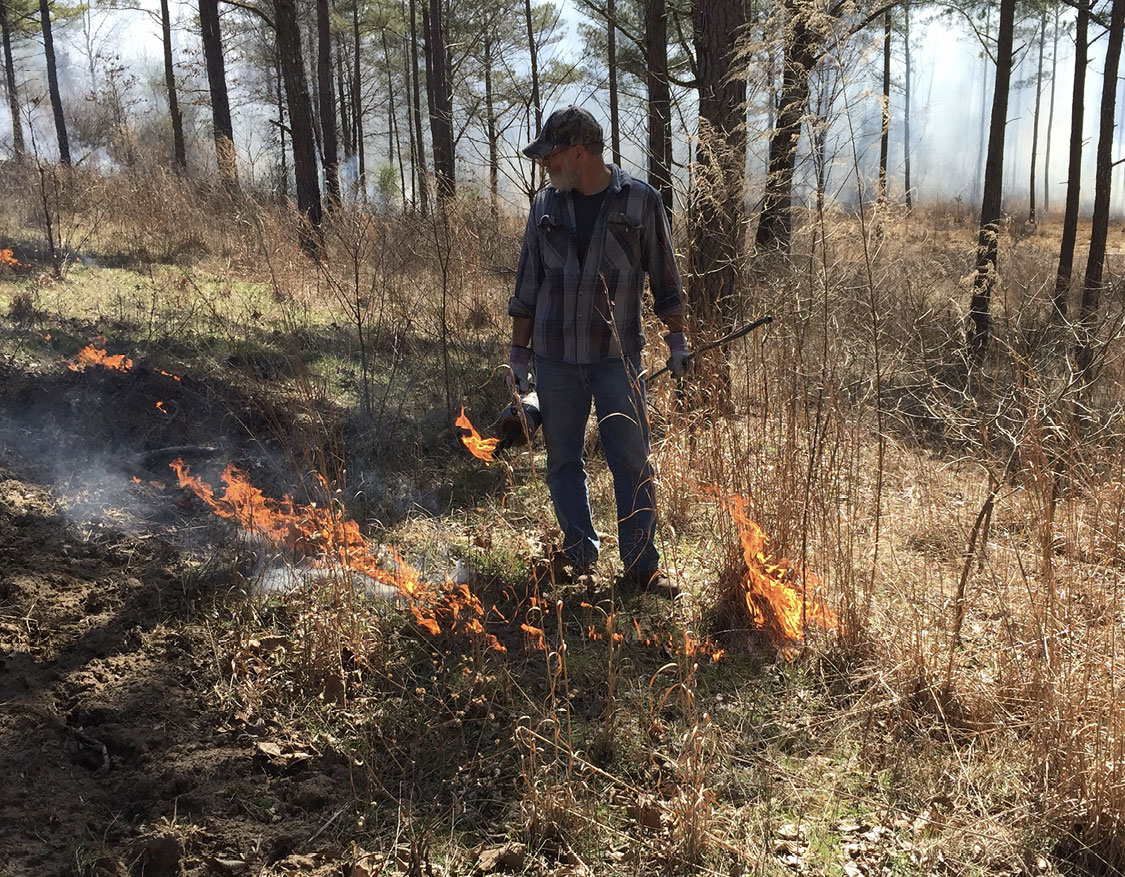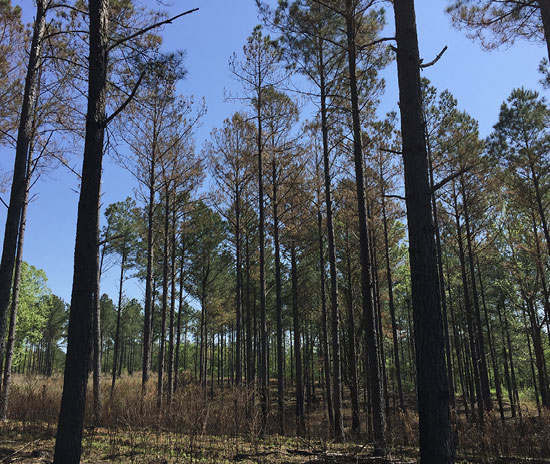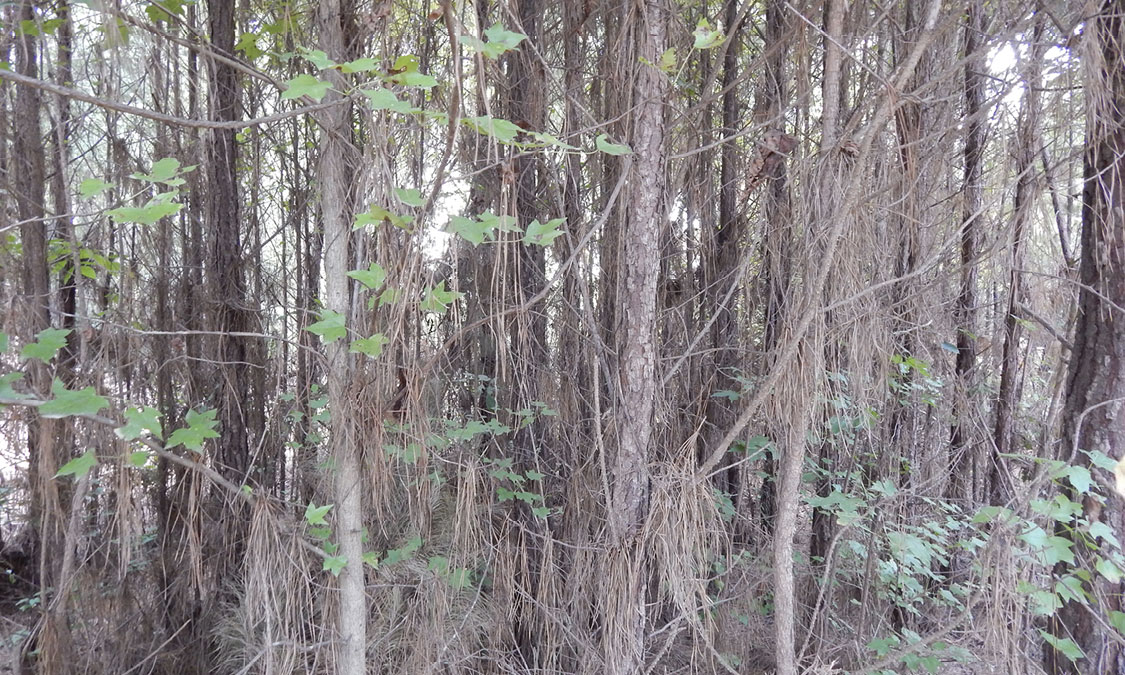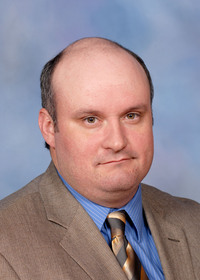When Will A Prescribed Burn Help My Pine Stand?
Fire is part of a healthy Southern pine forest. Fire can enhance productivity of pine forests, but it can also cause injury, poor growth, and death of desirable trees. Prescribed burning is the deliberate use of fire under suitable conditions to achieve specific forest management objectives (Figure 1). Since fire can both harm and benefit forests, landowners may wonder when prescribed burning is “right” for their forest. You should consider several important factors when determining if prescribed burning will help you manage your pine stands.

These factors include:
- your stand management objectives;
- tree diameter, height, and spacing;
- the amount of pine litter, brush, and other fuels beneath the pines; and
- the time of year to use fire to accomplish your objectives.
We recommend you seek competent professional forestry advice about using prescribed burning to reduce damage and potential liability.
Management Objectives
You will usually have more than one management objective for your pine stands. The main one may not be timber production, but you may want to manage for wildlife and/or natural beauty instead. Regardless of your overall goal, prescribed burning can help you reach all of these management objectives. It can help manage competing vegetation in pine stands that could otherwise reduce growth of desired trees as well as reduce the risk of wildfire damage.
Wildlife species such as turkey, deer, and quail benefit from plant growth stimulated by prescribed burns. Research has shown that both quantity and quality of understory food plants for these and other animals are improved through series of prescribed burns. Also, the edge between burned and unburned stands results in a diversity of plant species, which increases the variety of wildlife habitat on a landowner’s property.
Prescribed burning can improve the appearance of a stand by increasing visibility and stimulating the production of plants in the understory. Improved stand access can also improve recreational opportunities such as hiking and birding. Easier access created by prescribed burns can make future thinnings and harvest sales more attractive to timber buyers and loggers.
Condition of the Pine Stand
Often landowners ask, “How old should my pine trees be before I can use a prescribed burn?” Other factors are more important than the age of your trees. These factors include tree diameter, tree height, and tree spacing.
Tree Diameter
Diameter at breast height (DBH) is the diameter of a tree, outside the bark, at a point 4½ feet above the ground. Lower trunk diameter is a good indicator of a tree’s resistance to fire damage. Larger diameter trees have a thicker insulating layer of bark that protects the tree from heat. Pines with a DBH of 3 to 5 inches can usually withstand a low-intensity, winter season prescribed burn. Pines with 8, 10, and 12 inches DBH can tolerate higher intensity fires in different later seasons. Trees with a DBH less than 3 inches are typically damaged by fire and should not be burned.
Tree Height
As trees grow taller, they shed their lower branches. This creates space between fire on the forest floor and tender needles and shoots on living branches that can be damaged by fire. As distance between live pine branches and the forest floor increases, so does a tree’s tolerance to the effects of prescribed burning. If a stand contains live branches within 6 to 8 feet of the ground, a prescribed burn should be postponed for at least 2 years.
Tree Spacing
The spacing of pine trees impacts how quickly the lower branches of each tree will be shed. Closely spaced pines shed lower branches sooner than pines planted farther apart. In addition, crowns of closely spaced pine trees can trap heat from a prescribed burn beneath live branches. This heat can injure or kill pine needles and weaken the trees (Figure 2).

Although a closely spaced pine stand may appear to have a thick carpet of pine needles and twigs on the forest floor, all of this fuel may not burn at any given time. Weather conditions before and during the fire affect how much fuel is actually burned. Also, closely spaced pine trees will shed lower branches and needles earlier in life, thus increasing the amount of fuel available to burn. Close spacing inhibits fire by trapping moisture in pine litter and reducing the ability of brush or other plants to grow in the understory.
A closely spaced pine stand with dead branches close to the ground is a special concern. These dead needles are dry and extremely volatile. If you do not burn properly, these draped fuels can carry a fire from the forest floor into the canopy, causing severe injury and perhaps tree mortality (Figure 3).

These are the minimum general conditions that should be present before conducting a prescribed burn in your pine stand:
- An average DBH of 6 inches or greater
- A minimum distance of 15 feet to the lowest live branch
- Adequate canopy gaps to allow heat to escape
Time of Year
It is important to plan the first prescribed burn of a pine stand during the winter burning season. Cool air temperatures and more predictable winds create more favorable fuel moisture conditions for low-intensity fire that should cause minimal damage to pine trees. Prescribed burns conducted later or after earlier burns can be scheduled during other seasons to produce higher-intensity fires that will meet different objectives. For example, the best time to burn for control of understory brush and vegetation is late spring or early summer. Small understory hardwood species are more easily killed by a prescribed burn at this time.
Conclusion
Fire can be beneficial or damaging to pine forests. Prescribed burning can be a useful tool in pine management, but only when applied carefully by skilled practitioners. Other aspects of prescribed burning, such as cost, availability, and firing techniques, have not been discussed in this publication. Seek advice of local foresters if you are considering prescribed burning. Professional foresters can help you plan a safe burn—for both you and your pine stands.
Further Reading
- Managing the Family Forest in Mississippi, Mississippi State University Extension Publication 2470.
- Prescribed Burning in Southern Pine Forests, Mississippi State University Extension Publication 2283.
- Legal Environment for Prescribed Burning in Mississippi, MSU Forest and Wildlife Research Center research bulletin.
Publication 2262 (POD-08-22)
Revised by Brady Self, PhD, Associate Extension Professor, Forestry, from an earlier edition by Timothy Traugott, Extension Professor (retired), Forestry.
The Mississippi State University Extension Service is working to ensure all web content is accessible to all users. If you need assistance accessing any of our content, please email the webteam or call 662-325-2262.




